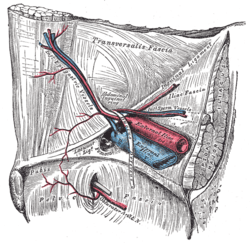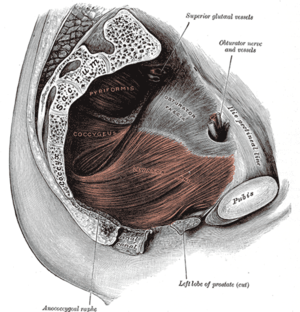Obturator artery
| Obturator artery | |
|---|---|
 The relations of the femoral and abdominal inguinal rings , seen from within the abdomen. Right side. (Obturator artery is visible at bottom.) | |
|
Internal iliac artery and some branches. | |
| Details | |
| Source | Internal iliac artery |
| Branches | anterior branch and posterior branch |
| Vein | Obturator veins |
| Supplies | Obturator externus muscle, medial compartment of thigh, femur |
| Identifiers | |
| Latin | Arteria obturatoria |
| TA | A12.2.15.008 |
| FMA | 18865 |
The obturator artery is a branch of the internal iliac artery that passes antero-inferiorly (forwards and downwards) on the lateral wall of the pelvis, to the upper part of the obturator foramen, and, escaping from the pelvic cavity through the obturator canal, it divides into both an anterior and a posterior branch.
Structure
In the pelvic cavity this vessel is in relation, laterally, with the obturator fascia; medially, with the ureter, ductus deferens, and peritoneum; while a little below it is the obturator nerve.
Inside the pelvis the obturator artery gives off iliac branches to the iliac fossa, which supply the bone and the Iliacus, and anastomose with the ilio-lumbar artery; a vesical branch, which runs backward to supply the bladder; and a pubic branch, which is given off from the vessel just before it leaves the pelvic cavity.
The pubic branch ascends upon the back of the pubis, communicating with the corresponding vessel of the opposite side, and with the inferior epigastric artery.
Outside the pelvis
After passing through the obturator canal and outside of the pelvis, the obturator artery divides at the upper margin of the obturator foramen, into an anterior branch and a posterior branch of the obturator artery which encircle the foramen under cover of the obturator externus.
The anterior branch of the obturator artery is a small artery in the thigh and runs forward on the outer surface of the obturator membrane and then curves downward along the anterior margin of the obturator foramen.
It distributes branches to the obturator externus, pectineus, adductores, and gracilis muscle, and anastomoses with the posterior branch and with the medial femoral circumflex artery.
The posterior branch of the obturator artery is a small artery in the thigh and follows the posterior margin of the foramen and turns forward on the inferior ramus of the ischium, where it anastomoses with the anterior branch.
It gives twigs to the muscles attached to the ischial tuberosity and anastomoses with the inferior gluteal artery. It also supplies an articular branch which enters the hip-joint through the acetabular notch, ramifies in the fat at the bottom of the acetabulum and sends a twig along the ligament of head of femur (ligamentum teres) to the head of the femur.
The blood supply to the femoral head and neck is enhanced by the artery of the ligamentum teres derived from the obturator artery. In adults, this is small and doesn't have much importance, but in children whose epiphyseal line is still made of cartilage (which doesn't allow blood supply through it), it helps to supply the head and neck of the femur on its own.
The articular branch is usually patent until roughly 15 years of age. In adults it does not provide enough blood supply to prevent avascular necrosis in upper femur fractures.
Variation

The obturator artery sometimes arises from the main stem or from the posterior trunk of the internal iliac artery, or it may arise from the superior gluteal artery; occasionally it arises from the external iliac.
In about two out of every seven cases it arises from the inferior epigastric and descends almost vertically to the upper part of the obturator foramen. The artery in this course usually lies in contact with the external iliac vein, and on the medial side of the femoral ring (Figure A on diagram); in such cases it would not be endangered in the operation for strangulated femoral hernia.
Occasionally, however, it curves along the free margin of the lacunar ligament (Figure B), and if in such circumstances a femoral hernia occurred, the vessel would almost completely encircle the neck of the hernial sac, and would be in great danger of being wounded if an operation were performed for strangulation. Because of this danger, this anatomic variant is sometimes referred to as the "crown of death" (corona mortis) .[1][2]
Additional images
 Right hip bone. Internal surface.
Right hip bone. Internal surface. Left Levator ani from within.
Left Levator ani from within.
References
This article incorporates text in the public domain from the 20th edition of Gray's Anatomy (1918)
- ↑ "Corona Mortis". Medical Terminology Daily. Clinical Anatomy Associates, Inc. 4 December 2012. Retrieved 6 October 2013.
- ↑ Rusu, Mugurel Constantin; Cergan, Romica; Motoc, Andrei Gheorghe Marius; Folescu, Roxana; Pop, Elena (28 July 2009). "Anatomical considerations on the corona mortis". Surgical and Radiologic Anatomy. 32 (1): 17–24. doi:10.1007/s00276-009-0534-7.
External links
| Wikimedia Commons has media related to Obturator artery. |
- Anatomy photo:43:13-0201 at the SUNY Downstate Medical Center - "The Female Pelvis: Branches of Internal Iliac Artery"
- pelvis at The Anatomy Lesson by Wesley Norman (Georgetown University) (pelvicarteries)
- MedEd at Loyola Grossanatomy/dissector/practical/pelvis/pelvis15.html
- Variations at anatomyatlases.org
- Variations at anatomyatlases.org